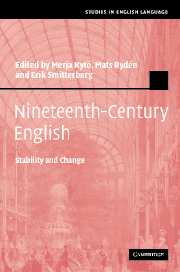Book contents
- Frontmatter
- Contents
- List of plates
- List of figures
- List of tables
- List of contributors
- Acknowledgements
- Introduction: Exploring nineteenth-century English – past and present perspectives
- 1 Modifiers describing women and men in nineteenth-century English
- 2 Words in English Record Office documents of the early 1800s
- 3 The subjunctive in adverbial clauses in nineteenth-century English
- 4 The passive in nineteenth-century scientific writing
- 5 Relativizers in nineteenth-century English
- 6 Anaphoric reference in the nineteenth century: that/those + of constructions
- 7 Adjective comparison in nineteenth-century English
- 8 Nonfinite complement clauses in the nineteenth century: the case of remember
- 9 The in -ing construction in British English, 1800–2000
- 10 Partitive constructions in nineteenth-century English
- Appendix
- References
- Name index
- Subject index
2 - Words in English Record Office documents of the early 1800s
Published online by Cambridge University Press: 22 September 2009
- Frontmatter
- Contents
- List of plates
- List of figures
- List of tables
- List of contributors
- Acknowledgements
- Introduction: Exploring nineteenth-century English – past and present perspectives
- 1 Modifiers describing women and men in nineteenth-century English
- 2 Words in English Record Office documents of the early 1800s
- 3 The subjunctive in adverbial clauses in nineteenth-century English
- 4 The passive in nineteenth-century scientific writing
- 5 Relativizers in nineteenth-century English
- 6 Anaphoric reference in the nineteenth century: that/those + of constructions
- 7 Adjective comparison in nineteenth-century English
- 8 Nonfinite complement clauses in the nineteenth century: the case of remember
- 9 The in -ing construction in British English, 1800–2000
- 10 Partitive constructions in nineteenth-century English
- Appendix
- References
- Name index
- Subject index
Summary
Introduction
English County Record Offices are ‘responsible for official and local authority records (both past and present) and also contain church and chapel records, the private records of businesses [and of individuals], local societies and political parties’ (Dewe 2002: 38). In this study I look at some of these records, which after about 1750 become plentiful for English written on all levels of ‘letteracy’ – minimally, partly, extensively and fully schooled.
I have restricted my research to England to avoid possible second-language interference, which could have occurred in partly schooled Welsh or Scottish English. The documents I look at are stored under three categories: (1) Church of England parish registers of baptism, marriage and burial; (2) bills written by and for artisans; (3) letters of application for relief, which members of the lower orders wrote (or got others to write) to parish overseers. Most documents were written between 1800 and 1835, but I also quote from others written earlier and later if I can connect them relevantly with those in the central period.
In these documents I look at certain classes of orthographic unit – that is, a group of graphs which a writer separated from other groups by two deliberate spaces. About 90 per cent of these groups are conventionally spaced words. I argue that how a writer wrote these units depended on their assumptions about the speaker and on how much and what type of schooling the writer had received.
- Type
- Chapter
- Information
- Nineteenth-Century EnglishStability and Change, pp. 56 - 88Publisher: Cambridge University PressPrint publication year: 2006
- 26
- Cited by



